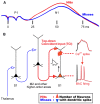Dendritic Spikes in Sensory Perception
- PMID: 28261060
- PMCID: PMC5309249
- DOI: 10.3389/fncel.2017.00029
Dendritic Spikes in Sensory Perception
Abstract
What is the function of dendritic spikes? One might argue that they provide conditions for neuronal plasticity or that they are essential for neural computation. However, despite a long history of dendritic research, the physiological relevance of dendritic spikes in brain function remains unknown. This could stem from the fact that most studies on dendrites have been performed in vitro. Fortunately, the emergence of novel techniques such as improved two-photon microscopy, genetically encoded calcium indicators (GECIs), and optogenetic tools has provided the means for vital breakthroughs in in vivo dendritic research. These technologies enable the investigation of the functions of dendritic spikes in behaving animals, and thus, help uncover the causal relationship between dendritic spikes, and sensory information processing and synaptic plasticity. Understanding the roles of dendritic spikes in brain function would provide mechanistic insight into the relationship between the brain and the mind. In this review article, we summarize the results of studies on dendritic spikes from a historical perspective and discuss the recent advances in our understanding of the role of dendritic spikes in sensory perception.
Keywords: bottom-up processing; dendritic integration; dendritic spike; neocortex; pyramidal neuron; sensory perception; top-down control.
Figures

Similar articles
-
A problem with Hebb and local spikes.Trends Neurosci. 2002 Sep;25(9):433-5. doi: 10.1016/s0166-2236(02)02200-2. Trends Neurosci. 2002. PMID: 12183194 Review.
-
Factors determining the efficacy of distal excitatory synapses in rat hippocampal CA1 pyramidal neurones.J Physiol. 1998 Mar 1;507 ( Pt 2)(Pt 2):441-62. doi: 10.1111/j.1469-7793.1998.441bt.x. J Physiol. 1998. PMID: 9518704 Free PMC article.
-
Dendritic calcium spikes are clearly detectable at the cortical surface.Nat Commun. 2017 Aug 17;8(1):276. doi: 10.1038/s41467-017-00282-4. Nat Commun. 2017. PMID: 28819259 Free PMC article.
-
Dendritic calcium spikes induce bi-directional synaptic plasticity in the lateral amygdala.Neuropharmacology. 2007 Jan;52(1):234-43. doi: 10.1016/j.neuropharm.2006.07.010. Epub 2006 Aug 4. Neuropharmacology. 2007. PMID: 16890250
-
Regenerative dendritic spikes and synaptic plasticity.Curr Neurovasc Res. 2004 Oct;1(4):381-7. doi: 10.2174/1567202043362144. Curr Neurovasc Res. 2004. PMID: 16181086 Review.
Cited by
-
Engrams of Fast Learning.Front Cell Neurosci. 2020 Oct 28;14:575915. doi: 10.3389/fncel.2020.575915. eCollection 2020. Front Cell Neurosci. 2020. PMID: 33250712 Free PMC article. Review.
-
Somatic Depolarization Enhances Hippocampal CA1 Dendritic Spike Propagation and Distal Input-Driven Synaptic Plasticity.J Neurosci. 2022 Apr 20;42(16):3406-3425. doi: 10.1523/JNEUROSCI.0780-21.2022. Epub 2022 Mar 7. J Neurosci. 2022. PMID: 35256531 Free PMC article.
-
CA1 pyramidal cells have diverse biophysical properties, affected by development, experience, and aging.PeerJ. 2017 Sep 19;5:e3836. doi: 10.7717/peerj.3836. eCollection 2017. PeerJ. 2017. PMID: 28948109 Free PMC article.
-
Learning enhances behaviorally relevant representations in apical dendrites.Elife. 2024 Dec 27;13:RP98349. doi: 10.7554/eLife.98349. Elife. 2024. PMID: 39727300 Free PMC article.
-
Dynamic interplay between thalamic activity and Cajal-Retzius cells regulates the wiring of cortical layer 1.Cell Rep. 2022 Apr 12;39(2):110667. doi: 10.1016/j.celrep.2022.110667. Cell Rep. 2022. PMID: 35417707 Free PMC article.
References
Publication types
LinkOut - more resources
Full Text Sources
Other Literature Sources

